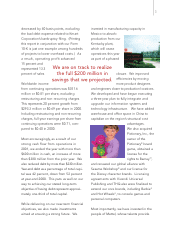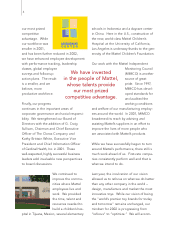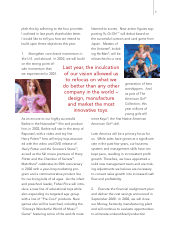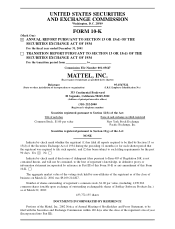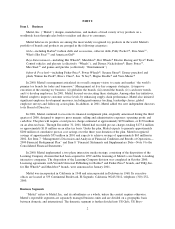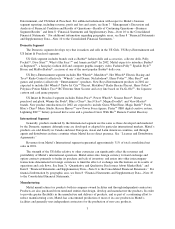Mattel 2001 Annual Report Download - page 13
Download and view the complete annual report
Please find page 13 of the 2001 Mattel annual report below. You can navigate through the pages in the report by either clicking on the pages listed below, or by using the keyword search tool below to find specific information within the annual report.Seasonality
Mattel’s business is highly seasonal, with consumers making a large percentage of all toy purchases
around the traditional holiday season in the fourth quarter. A significant portion of Mattel’s customers’
purchasing occurs in the third and fourth quarters in anticipation of such holiday buying. As a result of the
seasonal purchasing patterns and production lead times, Mattel’s business is subject to risks associated with the
underproduction of popular toys and the overproduction of toys that do not match consumer demand. Retailers
are also attempting to manage their inventories more tightly, requiring Mattel to ship products closer to the time
the retailers expect to sell the products to consumers. These factors increase the risk that Mattel may not be
able to meet demand for certain products at peak demand times, or that Mattel’s own inventory levels may be
adversely impacted by the need to pre-build products before orders are placed. Additionally, as retailers manage
their inventories, Mattel experiences cyclical ordering patterns for products and product lines that may cause its
sales to vary significantly from period to period.
In anticipation of retail sales in the traditional holiday season, Mattel significantly increases its production
in advance of the peak selling period, resulting in a corresponding build-up of inventory levels in the first three
quarters of the year. Seasonal shipping patterns result in significant peaks in the third and fourth quarters in the
respective levels of inventories and accounts receivable, which result in seasonal working capital financing
requirements. See ‘‘Seasonal Financing.’’
Product Design and Development
Through its product design and development group, Mattel regularly refreshes, redesigns and extends
existing toy product lines and develops innovative new toy product lines. Mattel’s success is dependent on its
ability to continue this activity. See Item 7 ‘‘Management’s Discussion and Analysis of Financial Condition and
Results of Operations—Factors That May Affect Future Results.’’ Product design and development are
principally conducted by a group of professional designers and engineers employed by Mattel.
Independent toy designers and developers bring concepts and products to Mattel and are generally paid a
royalty on the net selling price of products licensed to Mattel. These independent toy designers may also create
different products for other toy companies.
With respect to new product introductions, Mattel’s strategy is to begin production on a limited basis until
a product’s initial success has been proven in the marketplace. The production schedule is then modified to
meet anticipated demand. Mattel further limits its risk by generally having independent contractors manufacture
new product lines in order to minimize capital expenditures associated with new product introductions. This
strategy has reduced inventory risk and limited the potential loss associated with new product introductions.
Mattel devotes substantial resources to product design and development. During the years ended December
31, 2001, 2000 and 1999, Mattel spent approximately $176 million, $180 million and $172 million,
respectively, in connection with the design and development of products, exclusive of royalty payments. See
Item 8 ‘‘Financial Statements and Supplementary Data—Note 12 to the Consolidated Financial Statements.’’
Advertising, Marketing and Sales
Mattel supports its product lines with extensive advertising and consumer promotions. Advertising
continues at varying levels throughout the year and peaks during the Christmas season. Advertising includes
television and radio commercials, and magazine and newspaper advertisements. Promotions include in-store
displays, coupons, sweepstakes, merchandising materials and major events focusing on products and tie-ins
with various consumer products companies. Mattel has a retail store, American GirlPlace, in Chicago
featuring children’s products from Mattel’s Pleasant Company division.
During the years ended December 31, 2001, 2000 and 1999, Mattel spent approximately $662 million
(13.8% of net sales), $686 million (14.7% of net sales) and $685 million (14.9% of net sales), respectively, on
worldwide advertising and promotion.
5




